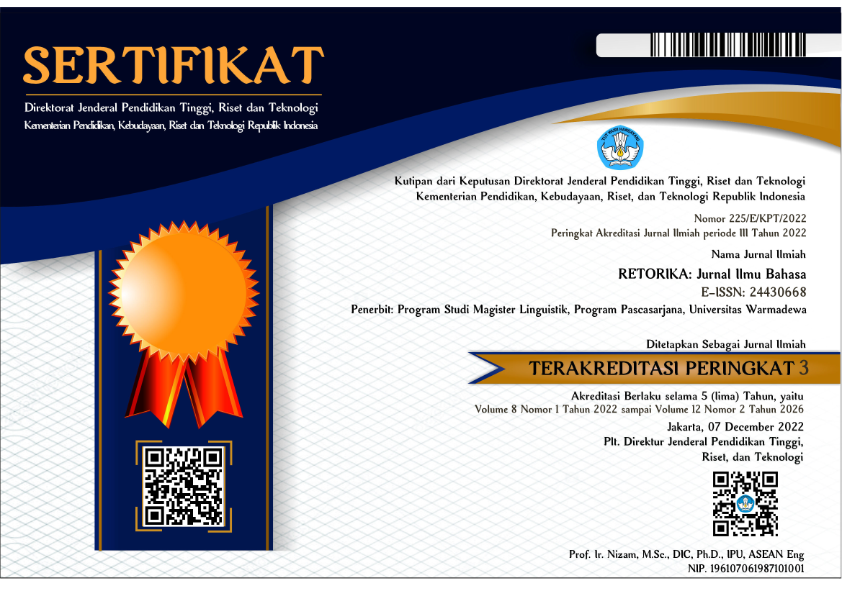Integrating Reduplication Patterns in The Western Flores Languages
Abstract
This study aims to look at the reduplication patterns in the Western Languages of Flores, i.e., MRK Language Subgroup (Manggarai, Rembong, and Komodo). These three languages are grouped according to the results of the calculation of the percentage of similar languages made by Fernandez (1996). Data was collected through secondary data collection from pre-existing datasets, including field notes and dictionaries. Direct interviews with native speakers representing each language strengthen secondary data with more in-depth information. The analysis revealed that there are similar patterns found in full reduplication accompanied by changes in vowel phonemes as in laki-lako 'going everywhere' in Manggarai, zupak-zapaq 'hassle' in Rembong, and cuki-cake 'naughty' in Komodo. Partial reduplication, on the other hand, generally takes the form of adding or removing final phonemes in repeated words, for example, bingi-bangas 'dull-witted' in the Manggarai Language, daki-dekang 'helping each other' in the Rembong Language, and hipi-hapek 'going here and there' in Komodo Language. The Rembong Language has a distinctive partial reduplication, the presence of rhyme sounds at the beginning as in ghali-ghewe 'miserable life' and at the end of words as in kameq-mok 'sucks'. Partial reduplication in Komodo Language only involves the repetition of the initial syllable as in kekaro (karo-karo) 'walkings'. It is hoped that this research can be a reference for further research to explore more deeply reduplication in the MRK Language, either refuting the results in this research or supporting it by providing more data
References
Asplund, L. (2020). Rembong-Wangka Its position among the Manggarai Languages, Some Formative Elements and Adnominal Possession. Stockholms Universitet: Typology and Linguistic Diversity.
Blust, R. A. (2013). The Austronesian Languages (Revised Edition). Pacific Linguistics, Research School of Pacific and Asian Studies, Australian National University. http://hdl.handle.net/1885/10191
Datang, F. A. (1998). Pola Urutan Kata Bahasa-bahasa Flores (Publication No. 15-17-052334753). [Thesis, Fakultas Ilmu Pengetahuan Budaya Universitas Indonesia]. Universitas Indonesia Library URI: https://lib.ui.ac.id/detail?id=77367&lokasi=lokal
Elias, A. (2020). Are the Central Flores Languages Really Typologically Unusual? In David Gil and Antoinette Schapper (Ed.), Austronesian Undressed: How and Why Languages Become Isolating (ix, 510 pp). Typological Studies in Language. https://doi.org/10.1075/tsl.129.06eli
Forth, G. 1988. Komodo as Seen from Sumba: Comparative Remarks on an Eastern Indonesian Relationship Terminology. Anthropologica XXX, pp. 44-63. https://doi.org/10.1163/22134379-90003306
Hammarström, H., Forkel, R., & Haspelmath, M., & Bank, S. (2020). Glottolog 4.2.1. Max Planck Institute for the Science of Human History.
Jer, F. M., Mahmoed, R., Putra H. M., & Soetomo, U. (2020). Analisis Perbedaan Reduplikasi Dialek Rahong dan Dialek Kolang dalam Bahasa Manggarai Provinsi Nusa Tenggara Timur. ALFABETA: Jurnal Bahasa, Sastra, dan Pembelajarannya, 3(1), 39-50. https://doi.org/10.33503/alfabeta.v3i1.716
Lon, Y. S., Sutam, I., Widyawati, F., Rampung, B., Sennen, E., Tatul, S., Dudet, B., Alang, A., Jelamut, M., Sawan, F., & Dangku, Y. M. (2018). Kamus Bahasa Indonesia – Manggarai. Penerbit PT Kanisius.
Mangga, S. (2020). Morphological Analysis of Manggarai Language. Parole: Journal of Linguistics and Education, 10 (2), 124–135. https://doi.org/10.14710/parole.v10i2.124-135
Margono, & Sutjaja, I. G. M. (1987). Struktur Bahasa Komodo. Jakarta: Pusat Pembinaan and Pengembangan Bahasa.
Mattiello, E. (2013). Extra-grammatical Morphology in English, Abbreviations, Blends, Reduplicatives, and Related Phenomena. De Gruyter Mouton. https://doi.org/10.1515/9783110295399
Maxwell, J. A., & Reybold, L. E. (2015). Qualitative research. In International Encyclopedia of the Social & Behavioral Sciences (2nd ed., Vol. 19, pp. 685–689). Elsevier. https://doi.org/10.1016/B978-0-08-097086-8.10558-6
Mora, M. (2022, January 25). Advantages of Secondary Research. Relevant Insight. https://www.relevantinsights.com/articles/secondary-research-advantages-limitations-and-sources/
Schmidt, C. K. (2013). Morphosyntax of Wangka, A Dialect of Rembong-Riung. [Thesis, Rice University]. RICE Digital Scholarship Archive.
Serzisko, F., & Haiduck S. L. (2012). Term Paper Reduplication in Austronesian. University of Cologne Department of Linguistics.
Timung, M. M. (2020). Reduplikasi Bahasa Flores. Jurnal Bahasa Dan Sastra, 5(3), 38-51.
Verheijen, J. A. J. (1977). Bahasa Rembong di Flores Barat. Ruteng: Regio S. V. D.
Verheijen, J. A. J. (1987). Pulau Komodo: Tanah, Rakyat, dan Bahasanya. Jakarta: Balai Pustaka.
Copyright (c) 2024 RETORIKA: Jurnal Ilmu Bahasa

This work is licensed under a Creative Commons Attribution-ShareAlike 4.0 International License.
This journal provides immediate open access to its content on the principle that making research freely available to the public supports a greater global exchange of knowledge.
All articles published Open Access will be immediately and permanently free for everyone to read and download. We are continuously working with our author communities to select the best choice of license options, currently being defined for this journal as follows: Creative Commons-Non Ceomercial-Attribution-ShareAlike (CC BY-NC-SA)
 Abstract viewed = 25 times
Abstract viewed = 25 times
 PDF downloaded = 23 times
PDF downloaded = 23 times

2.png)














